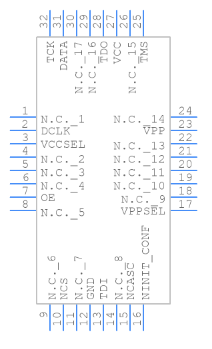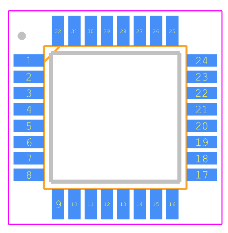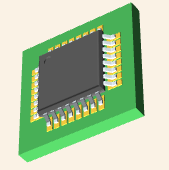EPC2TI32N FPGA: Features, Applications and Datasheet
2025-04-01 17:44:45 1628
EPC2TI32N Description
The EPC2TI32N is a configuration memory device manufactured by Intel (formerly Altera). It is part of the EPC2 series and is used to store configuration data for Intel's FPGAs (Field-Programmable Gate Arrays). The EPC2TI32N provides non-volatile storage, ensuring that the configuration bitstream for an FPGA is loaded upon power-up or reset. This specific device comes in a 32-pin TQFP (Thin Quad Flat Package) form factor and has a 2 Mbit (256 KB) memory capacity.
EPC2TI32N Features
Memory Capacity:
2 Mbits (256 KB) of configuration data storage.
Non-Volatile Memory:
Retains data even after the power is turned off, ensuring automatic FPGA configuration on power-up.
Supports Intel FPGAs:
Designed specifically for use with Intel (Altera) FPGAs such as Cyclone, Stratix, and Arria families.
Serial Configuration:
Uses a simple serial interface, reducing the number of required connections and simplifying communication with the FPGA.
Reprogrammable:
Allows for reprogramming of the configuration data, supporting design updates without hardware changes.
Temperature Range:
Operates within an industrial temperature range (-40°C to +85°C), making it suitable for a wide range of applications.
Compact TQFP Package:
Comes in a 32-pin Thin Quad Flat Package, which is compact and space-efficient for PCB designs.
EPC2TI32N Applications
FPGA Configuration:
Primarily used to store and load configuration bitstreams for Intel (Altera) FPGAs.
Embedded Systems:
Utilized in embedded systems where FPGAs are employed for flexible hardware configurations.
Consumer Electronics:
Suitable for devices such as set-top boxes, gaming consoles, and smart electronics that incorporate FPGAs.
Industrial Automation:
Deployed in industrial control systems where reconfigurable logic is required for automation processes.
Telecommunications:
Used in telecommunications and networking equipment where FPGAs manage complex data routing and protocol processing.
EPC2TI32N Alternatives
If the EPC2TI32N is unavailable or does not meet the desired requirements, the following alternatives may be considered:
EPC1PI8 (Intel/Altera):
A similar but smaller 1 Mbit configuration memory for Intel FPGAs.
EPC4QI100 (Intel/Altera):
A higher-capacity configuration device with 4 Mbits of storage for larger configuration needs.
M25P20-VMN6TP (Micron):
A 2 Mbit SPI Flash memory device that can be used to store configuration data for compatible FPGAs.
AT25SF041-SSHD-T (Microchip):
A 4 Mbit serial Flash memory device with an SPI interface, suitable for configuration storage in FPGA applications.
W25Q16JVSSIQ (Winbond):
A 16 Mbit SPI Flash memory device with greater storage capacity for larger FPGA bitstreams.
EPC2TI32N CAD Model
Symbol

Footprint

3D Model



EPC2TI32N Manufacturer
Intel Corporation, founded in 1968, is a global leader in semiconductor innovation and computing technology. Based in Santa Clara, California, Intel is best known for its development of microprocessors, which serve as the brains of most personal computers, data centers, and servers worldwide.
Intel's first major breakthrough came in 1971 with the launch of the Intel 4004, the world’s first commercial microprocessor. Over the decades, Intel has continued to drive advancements in computing with its x86 processor architecture, which remains the industry standard.
In addition to processors, Intel produces chipsets, solid-state drives (SSDs), graphics solutions, and field-programmable gate arrays (FPGAs). The company has also invested heavily in cutting-edge areas such as artificial intelligence, 5G, and autonomous driving through its subsidiary Mobileye.
With a commitment to pushing technological boundaries, Intel plays a crucial role in enabling faster, more efficient computing across a variety of industries, shaping the future of cloud computing, AI, and advanced data processing.
EPC2TI32N FAQ
1. What is the storage capacity of the EPC2TI32N?
The EPC2TI32N provides 2 Mbits (256 KB) of non-volatile memory for storing FPGA configuration data.
2. Which FPGAs are compatible with the EPC2TI32N?
The EPC2TI32N is compatible with Intel (Altera) FPGAs, such as the Cyclone, Stratix, and Arria series.
3. Can the EPC2TI32N be reprogrammed?
Yes, the EPC2TI32N is reprogrammable, allowing updates to the configuration data without hardware changes.
4. What package type does the EPC2TI32N come in?
The EPC2TI32N is available in a 32-pin TQFP (Thin Quad Flat Package), which is compact and suitable for space-limited designs.
5. What communication interface does the EPC2TI32N use?
The EPC2TI32N uses a serial interface for communication with the FPGA, simplifying the connection and reducing pin count.




